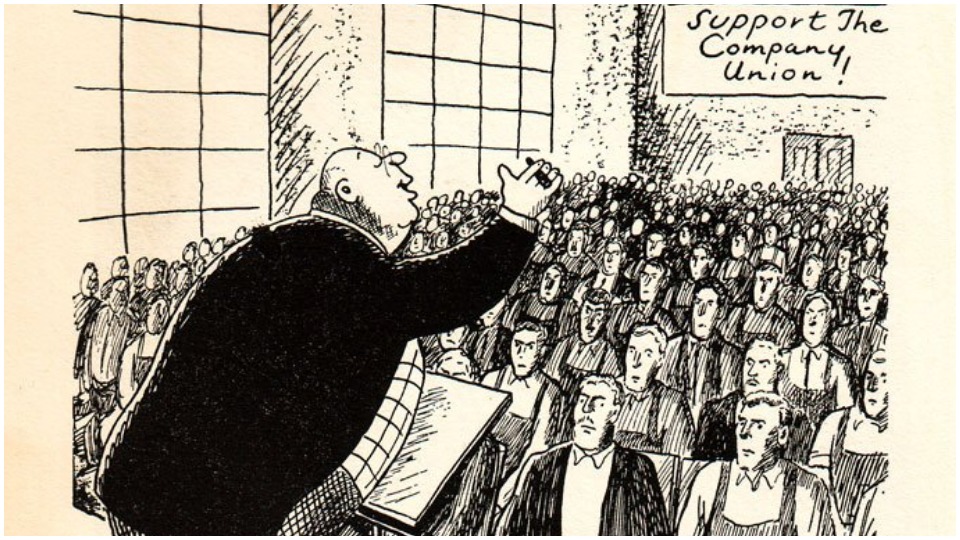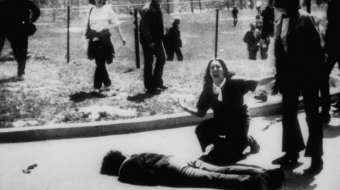
In December 1935, when the Daily Worker was but an 11-year toddler—yet a precocious and terrifying one at that—the Communist Party newspaper issued a 184-page, large format (7” x 10”) hardback collection of cartoons A. Redfield published in the paper. The generous volume, called The Ruling Clawss, reprinted one cartoon per page. Prompt Press, a union shop, printed the book, which bears the union label.
The collection has an introduction by Robert Forsythe (a pen name for Kyle Crichton) which places the cartoonist in the context of revolutionary and proletarian art of his time, and a concluding essay on “Social Satire” by the artist himself. Although some of the artists and writers referred to may not be familiar to current readers, the criteria for analyzing what is funny have not changed all that much.

Redfield’s figures are admittedly caricatures: The overstuffed matrons and the titans of industry with their top hats inevitably recall the game Monopoly or Marc Blitzstein’s labor musical The Cradle Will Rock. But the issues Redfield touches on in his art, a few examples of which we include here, are almost without exception the same we deal with today.
Redfield poked fun not just at the forgivable human foibles of the master class, but rather skewered the class system as such. In the mid-1930s—that would be in the depths of the Depression years—there were millions of Americans who instantaneously grasped Redfield’s pointed jabs. We believe that in the new Gilded Age we live in today, that is still the case.
Redfield was only one of many cartoonists who published regularly in the Daily Worker and successor mastheads. Others included Maurice Becker, Jacob Burck, Fred Ellis, Hugo Gellert, Jolan Gross-Bettelheim, Robert Minor, Ryan Walker, Jacob Kainen, later Ollie Harrington and others.
2019 marks a century since the founding of the Communist Party USA. To commemorate the anniversary of the longest surviving socialist organization in the United States, People’s World has launched the article series: 100 Years of the Communist Party USA. Read the other articles published in the series and check out the guidelines about how to submit your own contribution.
Now, who was A. Redfield? It was a pen name for a well known cartoonist named Syd Hoff (1912-2004), whose more mainstream work appeared regularly in The New Yorker and other media. Philip Nel, a professor of English and director of the Program in Children’s Literature at Kansas State University, has written about him in his blog Nine Kinds of Pie, where you can see other drawings from The Ruling Clawss, more than we have room to post here. According to Nel, “He wrote syndicated comic strips, satirical cartoons (both with and without teeth), children’s books, and even a 400-page illustrated history of political cartooning. All told, he was the author, illustrator, or author-illustrator of over 100 books.” Links provided in Nel’s blog lead to further information about the artist. Particularly notable is one entirely dedicated to Syd Hoff maintained by his niece Carol Edmonston.
Below we reprint the two essays in the book (slightly edited for format), to our knowledge for the first time anywhere since the original publication. These essays continue to say something even to our own time. Before we proceed to them, however, just a note about the particular copy of this book that fell into my hands (in Los Angeles, if that provides a clue). It bears a handwritten dedication, and possibly some reader might be able to identify the writer and the dedicatee:
“To Rose: My love for you is equalled only by my hatred for the capitalist system. —Bunny.”
Introduction by Robert Forsythe
With the desire we all have to act as God, I have tried to convince myself that I invented Redfield, but since I have only seen the man once and had nothing whatever to do with his start on the Daily Worker, I can comfort myself only with the fact that we are spiritual blood brothers.

For me to say that he is a fine satiric artist is to repeat only what the pictures themselves tell you. Of his background I know nothing. He may draw his ponderous-paunched females out of a sense of hatred accumulated through years as elevator man in a Park Avenue apartment house, but this hardly seems likely. To a man of Redfield’s apparent good sense, it would be extremely foolish to waste good rage over people as fundamentally ass-like as these. What actuates him, obviously, is a feeling of relief and gratitude and superiority. In great part, superiority.
The arrogance of the proletariat is always a source of concern to the upper classes. Acting upon the assumption that their eminence in life constitutes a condition about which the rest of the world should be envious, they are perpetually nonplussed at discovering that the workers, and particularly the revolutionary artists, consider them not objects of envy but subjects of great comic importance. The most casual examination of the Redfield drawings will convince one that far from being awed by the horrendous ladies and gentlemen, he is in a constant state of hilarity over them.
What the workers resent about the rich is not their wealth but the fact that they constitute a severe reflection upon the human race. I am constantly coming upon individuals so profoundly and elaborately grotesque as to drive the most radical cartoonist out of his head. Because Charles Dana Gibson and John Held, Jr., created whole generations of fantastic human beings, we are prone to believe that such men as Daumier and Robert Minor and Art Young and Redfield have done as much for the fabulous creatures we may see any evening of the week dining at such a place as the Hotel Plaza in New York City. There they sit—the women bejeweled, the men bejowled. You could no more be envious of such horrible spectacles than you could be envious of Hauptmann because his exploits have been chronicled upon the front pages of the newspapers. The idea that you could invent these people is ridiculous; no human mind is capable of such transcendental imagination.
The appearance of Redfield’s drawings in the Daily Worker is peculiarly fortunate for both. If upon occasion I speak harshly of such periodicals as The New Yorker and Life, it is with more sorrow than anger. At bottom, as must be clear, I have high regard for the capabilities of the ladies and gentlemen who conduct those magazines. What saddens me is the shocking disregard they have for their own talents and reputations. Redfield is a superior satirist; what makes him an outstanding figure is the material with which he deals. Approaching the problem of public conduct from exactly the same level at which it is attacked by most of the present-day artists, he brings to his work an incisiveness which is not possible in even the more sophisticated general magazines and newspapers. The fact of a social point of view makes him not only a more satisfied creator but obviously a more capable artist. Because I am a writer and have the usual guilty feeling that we are all rather bad characters, I may give too much credit to the good intentions and warm hearts of the artists, but the recent satiric issue of the New Masses (made possible by the brilliant labors of Gardner Rea) with contributions by the best of the cartoonists who regularly appear in more lofty publications seems an indication of the realization of the point I have been making. At the very least, it shows they are not afraid.
I suppose it is true that Redfield is a revolutionary rather than a proletarian artist. Whether the distinction means anything, I don’t know. What I am trying to say is that there are artists and writers who are good on attack—Jacob Burck, Phil Bard, Michael Gold, Joseph Freeman, Granville Hicks—and others, like Redfield and myself, who are strictly counter-fighters. Although my own background is proletarian—coal mines and steel works—I have lived so long in another way of life that it would be nonsensical of me to attempt a proletarian novel, for example. What I can do, and what Redfield is doing so superbly, is hack away at the vicious old existence with such weapons as we have at our command. In short, every man to his last. There are those who can build a new world and those who can help tear down the old. What makes Vincent Sheehan’s Personal History one of the most important books of our time is his realization of this truth. We may be so constructed that we are incapable of certain things which must be done in making a revolution but we can do what we CAN do. It may be a great deal, it may be very little, but we can do it. If nothing more, we can think straight.
Redfield has found his way and the Daily Worker has the good sense to help him pursue it. The fact that he uses a bourgeois technique for revolutionary ends has been criticized. I can think of nothing of less importance. If he preferred standing on his head and doing his work in the Rube Goldberg manner, it would be entirely all right with me. What he is doing is reflecting the honest disdain of the workers for the pathetic upper classes. This attitude is not forced in the slightest. Historically regarded, there is no more doubt of the triumph of the proletariat than of the sunrise. It has been established practically in the Soviet Union; philosophically and culturally, it has gained ascendancy everywhere. No artist in his right mind would think of linking his fortunes with the specimens which now pass as our aristocracy.
But this is too ponderous for a discussion of drawings which are so biting and cauterizing and delightful as these. The delight, I am afraid, is all on our side, but even the gorgeous half-wits who cut the wages and prepare themselves fatuously for fascism get some pleasure out of realizing that they can be so awesomely ridiculous. In a sense, they are a triumph. A triumph of matter over mind, of course; but a triumph.
Dec. 2, 1935
* * * * *
The Artist Says a Word About Social Satire
Some time ago I had an argument with a friend who, though he is quite reactionary, considers himself a sympathizer. That is, he feels sorry for us. He picked up a copy of The New Yorker and said, “Show me a single drawing in here that is not funny.” I pointed out that in about twelve drawings six struck me as being quite humorous. He said, “That proves that there is such a thing as bourgeois humor.” I told him I hadn’t tried, and wouldn’t try, to deny that there was such a thing as bourgeois humor. But I assured him that bourgeois humor has its limitations and that it was solely used by the bourgeoisie to whitewash itself. My friend leaped into the air. “What the hell do you mean?” he said. I then calmly proceeded to explain to him that society was mainly divided into two classes, an oppressed class and a class of oppressors. In general, I described the bourgeoisie as being the class in society which consciously prepares new onslaughts on the oppressed.

“But,” my friend interjected, “when I want humor, I want to forget all about that. I want to forget that my position in society is insecure, and war and fascism are just around the corner. When I want to laugh I want to forget about everything.” I asked him then, whether he was a dope addict. He heatedly replied that he was not. I then assured him that if bourgeois humor made him “forget,” dope would also, and therefore bourgeois humor is, as Marx said of religion, the opium of the masses. Picking up copies of The New Yorker, Esquire, Judge, Life, etc., I went on to show him how these publications were making a general pancake of society. That is, taking the banker boys and politicians, who are the rapers of liberty and democracy, and presenting them between perfume ads in whimsical situations. And how does the bourgeoisie make itself look human? By exposing itself in the boudoir, or the night club, doing foolish things or saying something “funny.” In other words, the fascists and warmongers are little lambs who do their parts in contributing to the merriment of a nation.
My friend now “tore” into the Soviet Union. “Suppose,” he demanded, “an incident happened in Russia, where a worker is the scapegoat of a joke—would Stalin print it?” I assured him that Joseph is the kind of a fellow who has, at all times, the interests of the masses at heart, and that if the joke were against the working class, he would probably reject it. In fact, in the Soviet Union humor is an instrument in the hands of the working class. There, satire is used, not as a medium of escape, but as an amusing and educational means of improving the cultural level of the masses.
At this point let us examine some of the outstanding humorists of today. Let’s take Will Rogers—wait a minute, let the dead rest. Anyway, Will was the type of comedian who very often attacked bankers, presidents, etc. But it was peculiar to notice that the same people whom he ridiculed very often were his hosts at lavish banquets and cocktail parties. In other words, society appreciated Will because his humor never went below the skin.
If Will had ever exposed his friends’ real political life, they would not have contributed to a memorial for him—rather, they would have handed him a deportation notice and the poor cowboy would have been sent back to his Golden West. The same holds true for Eddie Cantor, Peter Arno, Robert Benchley, and about a thousand others who carry “light into the dark.”
Around about 1929, a new institution loomed on the horizon of American life. It came at a time when people had nothing to laugh at. Breadlines were springing up and the nation was taking orders from Moscow. Ballyhoo was born. This magazine discovered sex in the grandest style ever imagined by any genius publisher. Where sex, in the other existing magazines, could only be understood by a lucky handful of people, Ballyhoo brought it forward in a most militant manner. History was made by a great editor who suddenly brought ladies’ drawers out from their places of hiding and featured them in double spread drawings. Plumbers came into their own…bricklayers…house painters… steel workers…anyone who had an opportunity to peek into a lady’s bathroom.
So great was the success of this magazine that on all sides imitators sprang up. Bunk, Hooey, Hooey-Balooey and Baloney were a few that flooded the market. The circulation was great until the country caught its breath and realized once again that sex was only an instinct. While all this was going on, it is easy to imagine that great American satirist of nearly half a century, Art Young, barricading the doorway of his cottage in Connecticut, and observing the twilight of bourgeois culture.
Art Young was probably the greatest satirist of his day. He drew for Life, Judge, Liberator and Masses many years ago. Probably the greatest of his reflections on the misery and hopelessness of life under capitalism was contained in a single drawing which Art had in the old Masses. The scene showed a tired worker and his wife. The man says, “Begorra, Maggie, I am tired.” She, bending over a washtub, says, “You’re tired! Here I am, standing over a hot stove all day, while you work in a nice cool sewer.” If this was the only drawing that the old master ever did, I believe that it would have won him, some future day, immortality in a workers’ America.
Today we have a new crop of satirists who, at the same time that they bite the bourgeoisie, use only their lips, but not their teeth. Peter Arno is reckoned to be the greatest of them all. There is no denying the man’s greatness as an artist. He is probably the greatest producer of wash drawings today. His caricatures are ruthless in their attack, but Arno does not comprehend the significant position in society of the people whom he “attacks.” He does not question once their right to rule and exploit, to create war and fascism, to bring misery and despair to the oppressed masses. Rather, he limits himself only to exposing the bourgeoisie as feeble-minded, sex-starved creatures who reveal in their boudoir cavortions. Love and champagne are the only vices, to Arno, of the warmongers and makers of fascism.

Another great master of satire is Soglow. Soglow, as you know, is the creator of one of the most famous characters in American humor, the little king. In the beginning the king was quite an interesting character. Soglow began by exposing the royalty as the parasitic class which it is. The king was a ridiculous character who did all sorts of stupid things. At this time, it might be mentioned that Soglow was quite close to the revolutionary movement, but gradually, as fame and fortune carried him away, the king slowly began to assume a more human appearance. Instead of being a character whom people laughed at with a feeling of contempt, the king became an object of pity, until today people smile at his antics only half-heartedly as they recognize the monarch doing familiar things that we all do. Thus, Soglow has vindicated the royalty. Even Hearst is his patron today.
Let us now discuss the comic strip, which has been a form of American humor for about forty years. The first strip we shall look at is Little Orphan Annie. Who is this nine-year-old philosopher who has a dog named Sandy? She is a woman of the world who makes many trenchant observations on the perplexities of civilization. In January of any year Annie may be broke and hungry, but there is always February, when she will become rich. But, alas and alack, many are the moods and caprices of her great creator, who is destined to make her starve in March again. We do not know how true it is that one day the artist picked up a copy of one of the many papers in which Little Orphan Annie is syndicated and observed, “M’Gawd, here it is August and Annie is rich!” So the great satirist ran home and made Annie poor again. I fear that the day is not long when Annie won’t live here any more.
Another strip is Andy Gump. Andy has been in the public eye for about twenty-five years. We find an Uncle Bim, who is a billionaire. And what, according to the creator of the strip, is the occupation of a multi-billionaire? Why, he simply gets into a limousine, rides through a ghetto, heaving tremendous bags of gold into the laps of the poor. Then there is Jiggs, who is supposed to typify the average American. All that this splendid example of Americanism asks is that he be allowed to eat corned beef and cabbage, and his main complaint in life is that there is always Maggie who awaits him every night with a rolling pin. Let no one of the millions of people who are disillusioned with the wretchedness of their existence under capitalism question the veracity of Jiggs. He is the ideal which the patrons of society would like the masses to pattern themselves after.

Another kind of a cartoon which has suddenly been popularized is the one which deals with the police. I don’t think I have to explain the function in capitalist society of the police. It will suffice to say that they are used to break strikes, to smash demonstrations of hungry workers and, in general, to protect the interests of the ruling class. However, in the Dick Tracy form of cartoon, we find that the police become genuine “servants of the people,” at all times eager and willing to aid the suffering citizenry. Never is Tracy the kind of a cop who breaks his club over a worker’s head. Indeed, his publishers would have us believe that the police are Robin Hoods whose every campaign is against vice and crime, and are never used to terrorize the masses of people.
Then there is the Skippy type of cartoon. Here we find bright-faced little children who never grumble about malnutrition, or the fact that they must go to school with feet unshod, but rather philosophize on the economic conditions of the state. Thus, its creator will have his puppets discuss the size of the Navy, the strength of our Army, whether we really are prepared for Japanese invasion and, in general, are just fun-loving children with youthful fantasies and the brains of Hearst. Many strips are based on the ones which I have discussed.
What I have done here is attempt a general analysis of the humor we see in the comic supplements and the smooth paper weeklies and monthlies, as well as the kind we hear from the stage and over the radio. The men and women who draw Jiggs, Andy Gump, Skippy, Moon Mullins and the host of other strips…the Arnos, Soglows, Benchleys and Cantors…are all talented and funny, but…and here, I believe, is the point… their comedy is all too often a whitewash for people and conditions that, in reality, are not funny.
A. Redfield










